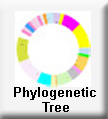


|
|
Female:
Body
almost straight, only slightly curved ventrad after fixation. Head
rounded; submedian lobes or lips
only slightly distinguished on anterior surface. Head sclerotization
light; stylet guiding apparatus appears as two darker, almost straight
lines near base of sclerotization. Stylet slender; slightly curved
ventrad; knobs moderately developed, backwardly directed. Length
of stylet shaft, plus
knobs 8 mm [7 (5-10) mm
in paratypes]. Excretory
pore near base of stylet [see
drawing, fig. 1]. Hemizonid small; immediately posterior
to excretory pore. Valve in metacorpus 9 micrometers long.
Isthmus distinct, slender, 11 mm long, 2 mm
wide. Esophago-intestinal valve small, lobate. Ovary outstretched;
spermatheca elongate, about twice as long as wide; filled with sperm [see
drawing, fig. 2]. Vulva lips rounded; protrude slightly,
lateral vulvar membranes lacking. Tail
broadly
conoid; tapers only slightly to bluntly rounded terminus. Average
width of body annules ranges from 1.0-1.4 mm
(1.0-1.6 in paratypes). Lateral
field with 3 incisures equally spaced; inner incisure lighter than
outer 2 [see
drawing, fig 3].
Swollen
female: Body variously swollen; greatly variable in size [see
drawing, fig. 5-6]; often reniform with distinctly projecting tail.
Head rounded. Stylet of fully swollen females invariably broken in
collection process. Metacorpus greatly enlarged, 20-28
mm
in width; swells gradually but major swelling 30-35 mm
long. Isthmus remains slender but posterior bulb enlarges slightly
to 9-10 mm wide by 11-13 mm
long. Ovary coils many times; few eggs seen are oval, nearly spherical
and occur singly in uterus. Body narrows abruptly immediately posterior
to vulva; then becomes broadly conoid; tapers slowly to blunt rounded terminus.
Cuticle very thick, with annules coarse, especially in head region.
Lateral field indistinct in most swollen females; seen as 3 incisures in
a few. Tail elongate and terminus bluntly rounded. Swollen
females found completely inside root tissues of host plant.
Male:
Body curves slightly ventrad after fixation. Head rounded; sclerotization
light [see
drawing, fig. 7]. Stylet lacking; esophagus degenerate.
Hemizonid immediately posterior to excretory pore. Testis outstretched,
with large, irregularly-shaped cells in anterior half; filled with numerous
smaller sperm in posterior half [see
drawing, fig. 8]. Testicular gland distinct (40-49 mm
in paratypes). Spicules curve very slightly ventrad. Cloacal
sheath short, without projecting posterior margin. Indistinct caudal
alae extend about 8-9 mm anterior and posterior
to cloacal opening. Tail broadly conoid; annules distinct almost
to bluntly rounded terminus. Average width of body annules ranges
from 1.0-1.4 mm. Lateral field with 3
incisures as in female.
This species is
most closely related to G. aculenta from which it differs in longer
stylet [58 (51-66) mm for
G. aculenta]
and length of esophagus (b = 2.4-4.1 in G. aculenta).
Type
host: mesquite, Prosopis sp.
Type locality:
Weslaco, Texas.
Distribution:
9 females, 3 males and 2 juveniles found in soil about roots of Mesembryanthemum
sp. at Dillon Beach, Marin County, California; 7 females, 2 males and 3
juveniles from soil about strawberry, Noyo, Mendocino County, California.
Notes: Determined
by Peter Mullin. G. latescens is apparently rare in prairie
soils (we've only seen 7 slender females out of over 4000 nematodes examined;
no males or juveniles of sthis species have been observed); this may be
due in part to its endoparasitic feeding habit later in life. We
have also recovered one specimen of G. aculenta (i.d. based primarily
on stylet length and b ratio) from our Konza samples. In addition,
specimens of an undetermined Gracilacus species have been recovered
from 9 Mile Prairie near Lincoln, Nebraska, which are similar to G.
latescens, except that the slender females appear to uniformly retain
the fourth-stage juvenile cuticle and the stylet, while very degenerate,
remains visible in the males.
Comparison between G. latescens paratypes and specimens from Konza Prairie:
|
|
|
|
|
L (mm):
|
|
|
|
b:
|
|
|
|
V:
|
|
|
|
Stylet (mm):
|
|
|
References:
Raski, D.J. 1976. Revision of the genus Paratylenchus Micoletzky,
1922 and descriptions of new species. Part III of
three parts - Gracilacus. J. Nematol. 8: 97-115.
Raski, D.J. 1991. Tylenchulidae in agricultural soils.
Chapter 17, pp. 761-794 in: Manual of Agricultural
Nematology,
W.R. Nickle, ed. Marcel Dekker, Inc., New York.
Siddiqi, M.R. 1986. Tylenchida: Parasites of Plants and
Insects. Commonwealth Agricultural Bureaux, Slough, UK.
645 pp.
The most notable features of this nematode
are its small size (260 - 288 mm in our specimens,
with an average of 270 mm) and its extremely
long stylet (64.8 - 71.2 mm, average 68.6 mm).
As part of a survey of nematodes associated with various tallgrass prairie
plants, we've found
G. latescens associated with roots of several
grasses, including big bluestem, little bluestem, Scribner's panicum, and
bluegrass. In this species, as in at least some other species of Gracilacus,
the mature females are sessile endoparasites and as they feed, become large
and swollen with age. Since we have not yet dissected any roort tissue
(focusing on soil extracts), we have not recovered any such swollen forms
from our samples.
This species included in the Criconematid Project
DNA Sequences Obtained
| Specimen: | Collected: |
| KonzaI AC-89 | Konza Prairie, First survey |
 |
 |
 |